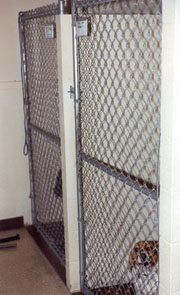Canine distemper virus (CDV)
can infect not only dogs, but wild canids (wolves, coyotes, foxes), exotic
felids (lions, jaguars, cheetahs), and other animals (bears, skunks, raccoons,
and ferrets). Canine breeds that seem to be more at risk include the Arctic
breeds (Samoyeds, Malamutes, Huskies), Greyhounds, and Weimaraners. Among
domestic dogs, the group most at risk is unvaccinated puppies.
Causative Agent: Distemper is caused by a virus of the Paramyxovirus
family and is closely related to the virus that causes measles in humans.
Clinical Signs: Symptoms vary widely and are dependant on many factors. Lethargy, anorexia, fever, discharge from the eyes and/or nose, and
coughing are
common in mild cases. In more severe cases, the animal will often experience
vomiting and diarrhea, straining to defecate, dehydration, and sudden death. Seizures, balance problems,
weakness or paralysis, and involuntary twitching of
the muscles are all possible and tend to worsen with time. Weeks to months after apparent recovery, some dogs will begin to have
additional problems
with the nervous system. There is no way to predict which dog will develop
nervous system problems, but those that do usually have a much poorer outcome.

|
|
|
| This
kennel is designed to keep animals in different cages from having
"nose to nose" contact with each other. The walls between
each kennel are made out of cement, and therefore, are easy to keep
dry and clean. These features greatly reduce disease transmission. |
|
Disease Transmission: Natural infection is spread through respiratory
secretions of infected animals. These infections can occur in many kennel
situations. Transmission to the fetus through the placenta can occur even with
mild or inapparent infections in the mother.
Diagnosis: A definitive (precise) diagnosis of CDV infection is
challenging. Several specific tests have been developed for the detection of CDV
to aid in the definitive diagnosis of the disease; however, a presumptive
(preliminary) diagnosis is
usually made based on history and symptoms of the animal. If
an exact diagnosis is needed, samples can be taken and sent to a laboratory.
These samples may include serum, biopsies, and cerebrospinal (spinal cord)
fluid. While the samples are being evaluated by the laboratory, blood work and X-rays
are often used to help put together a treatment plan, and supportive care should
be started immediately.
Treatment: Treatment for CDV infection consists mainly of supportive
care, because no specific therapy exists which will seek out and destroy the virus
itself; the animalís own immune system must accomplish this task. Therapy
includes antibiotic therapy to fight secondary infections (especially
respiratory infections such as pneumonia), fluid therapy to correct dehydration,
anti-emetic therapy to help alleviate vomiting, anti-convulsive therapy to aid
in management of seizures and other neurologic problems, and occasionally,
steroid therapy if swelling of the brain is thought to be a complication.
Prevention: Vaccination remains the most effective method of preventing
CDV infection in dogs. A vaccine made for dogs from human measles virus is
sometimes used as the very first vaccination in puppies 6-9 weeks of age. This
vaccine gives protection at a time when the routine canine distemper vaccine
often fails due to antibodies obtained from the motherís milk. This measles
vaccine is not given to puppies older than 9 weeks of age. Healthy puppies and
adults older than 9 weeks should receive a modified live virus (MLV) canine
distemper vaccine. Most varieties of the MLV distemper vaccine involve a living
virus that has been attenuated or altered to avoid causing the disease. However,
in very rare circumstances have allowed these live viruses can revert to their
infective forms and cause serious infection. For example, vaccination of female
dogs during pregnancy or the first few days after delivery has resulted in
distemper infection of the puppies. Also, puppies suffering from parvo or other
serious infections should not be vaccinated against distemper with a living
virus vaccine, because there have been cases of vaccine-caused infections reported.
Only healthy puppies and adults should receive this vaccine. See A900
for additional information on passive immunity and MLV vaccines.
